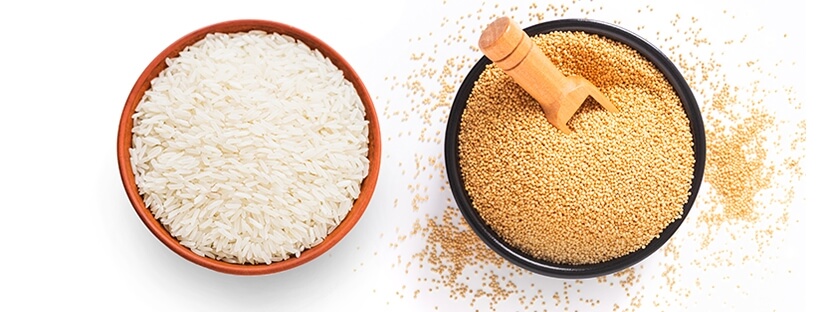Rice Vs. Millets- Comparisons, Benefits, Drawbacks
 25526
25526

super easy
We hear so much about millets these days, about how they should be incorporated into your meals for a healthy and well-balanced diet. There has been a resurgence in the popularity of millets lately, with many nutritionists advocating the benefits of millets over rice. But what exactly are millets, and what are their benefits?
What are Millets?
Millets are cereals and small seed grasses grown and widely used in Asia and Africa. They are used for human consumption as well as fodder for animals. Millets are easy to grow as they are very tolerant of drought and other extreme weather conditions, though their growing season can be very short. Some common millet species are foxtail millet, proso millet, finger millet, pearl millet, Kodo millet, sorghum, little millet, barnyard millet, etc.
Like most other cereals, millets are high in nutritional content and are therefore recommended for diabetics and also for those with gut issues. Millets are rich in proteins, dietary fiber, vitamins, minerals such as potassium, phosphorus, iron, and magnesium. They are mostly used to make flours.
What is Rice?
Rice is also a cereal and is eaten widely all over the world. Rice is rich in carbohydrates, proteins, and nutrients such as iron and manganese. However, rice contains simple carbohydrates, which get digested quickly and can cause an increase in blood sugar, making it unsuitable for diabetics. Because of this, rice can also lead to obesity.
Difference Between Rice and Millets
- Dietary Fibre- While rice also has dietary fiber, millets are much higher in fiber content.
- Protein- Rice has 3% protein as compared to a much higher amount of proteins in millets.
- Vitamins & Minerals- Millets are also higher in vitamins and minerals as compared to rice.
Benefits & Drawbacks of Millets
- Millets are rich in antioxidants, which are said to have anti-inflammatory properties. Darker-colored millets have more antioxidants than lighter ones.
- Because of their high-fiber content, millets help in controlling blood sugar. They have a low Glycaemic Index (GI), which helps in preventing blood sugar spikes.
- Millets help to lower cholesterol levels.
- Millets are gluten-free, which makes them ideal for people suffering from celiac disease or other gut issues.
- However, despite all their benefits, millets do have a drawback too. Millets are known to contain some antinutrients such as phytic acid, which prevents the absorption of some important vitamins and minerals. Millets also contain goitrogen substances that interfere with the production of the thyroid hormone and may result in goiter.
So, since millets have a higher fiber, protein, and mineral content as compared to rice, should you eliminate rice completely from your diet and substitute it with millets? A well-balanced, healthy diet is essential for your well-being. Having everything in reasonable amounts prevents any deficiency in the body unless you have been advised by a doctor to eliminate any particular food group from your diet. Millets too, have their drawbacks (as discussed above), therefore do not substitute rice completely with millets, but you can have them once or twice a week.
Follow us-
Instagram/ Facebook/ Youtube/ Pinterest
Also read:





Leave a Reply